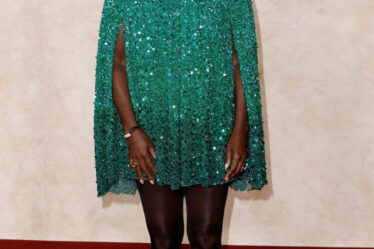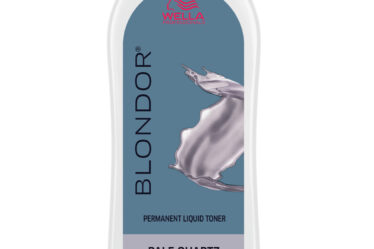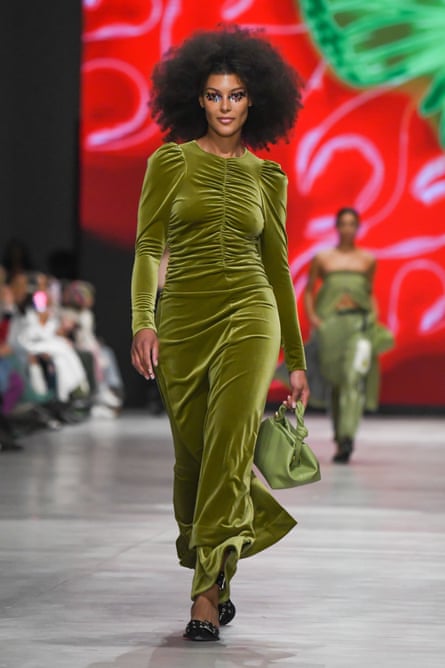
What do you do if you’re a designer who is trying to be more sustainable but you want to show at fashion week? For Emilie Helmstedt, a Danish designer who took part in last week’s Copenhagen fashion week, the solution for the footwear styled with her dresses came from her team who brought in their old Nike and Adidas trainers. Covering them with ribbons, beads and paint, Helmstedt decided it was better than using new versions, as she has done in the past. It also chimed with the rest of the collection – her finale look which was made from scraps of material accumulated in her studio.
Copenhagen fashion week started in 2006 with relatively low-level fanfare. Then, three years ago, Danish organisers set out a series of sustainability requirements for designers to meet in order to be allowed to show in 2023 which would set them apart from the main fashion weeks – New York, Milan, Paris and London – on the global calendar
Based on the United Nations sustainable development goals, the organisers decided on 18 requirements that would apply to the event itself, as well as to all designers who wanted to participate.
“I had a clear idea of what I wanted to do differently. It was about time to set specific requirements rather than just give guidelines,” says Cecilie Thorsmark, the chief executive officer of Copenhagen fashion week (CPHFW) who outlined these requirements, which include a rule that 50% of a collection must be made using textiles from new generation materials such as alternatives to animal-derived raw materials like leather. Deadstock, recycled or upcycled materials are also encouraged.
Most brands have dropped fur from collections but, here, fur is banned outright and any unsold stock from previous collections cannot be destroyed – the most prevalent technique, burning and slashing items, was employed by brands including Burberry in the past. Instead, brands are to sell to discount outlets such as TK Maxx or enter them into the circular economy. Brands must also ensure, by exercising due diligence and working with suppliers, that chains are free from child labour and factories provide safe and fair working conditions.
Thorsmark, who previously worked for the Global Fashion Agenda, an industry group focused on sustainability, says she took the job in 2018 to challenge both the role and purpose of fashion week.
Implementing the requirements was a risk. CPHFW didn’t want to lose the bigger commercial names such as Ganni that attract international press and buyers. Thirty brands were approached with 28 qualifying three years later. Applications were first reviewed by a show committee made up of industry experts, then reviewed and verified by Ramboll, an external consultancy company.

One brand dropped out of the process halfway through while another was rejected after failing to meet all 18 obligations (Thorsmark wouldn’t reveal which brand it was).
On paper, it’s encouraging news from what is often considered the fifth fashion week. But despite the changes many remain sceptical.
Ciara Barry, policy and campaigns manager at the non-profit Fashion Revolution, is currently mandating for living wage legislation across the fashion sector. She says it is concerning that the requirements don’t even mention fair pay. “There is an inherent hypocrisy with a glamorous fashion show displaying collections which are made in poverty. All players in the fashion industry should call for systemic change – and fashion weeks have a role to play in this.”
Barry says the omission also highlights the challenges that independent brands face from larger fast-fashion brands. “The nature of fashion’s supply chains make it incredibly difficult for individual brands to ensure living wages on their own,” says Barry. “They all share factories and suppliers.”
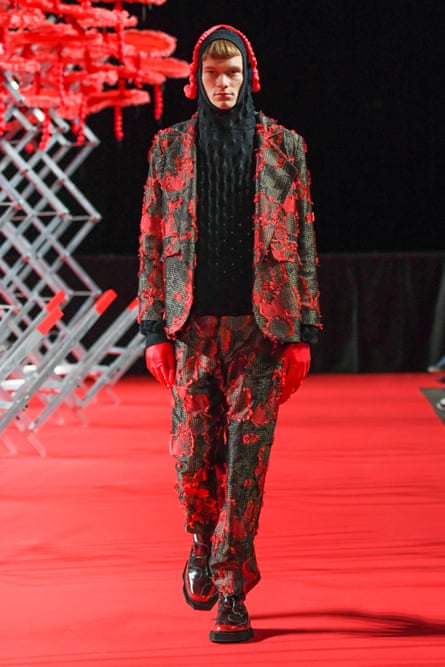
Then there are the double standards around offsetting carbon emissions. In order to meet the zero waste requirement, brands sent digital QR codes in place of embossed paper invitations. Single-use plastic was banned, show sets were minimal and all props had to be reused. Meanwhile, members of the press and fashion buyers flew in from around the world to look at even more new clothing that was being produced.
On the ground, the designers themselves were mainly optimistic about the changes. Henrik Vibskov, who has been showing for more than two decades, felt the requirements finally acknowledged the steps he has been trying to implement since 2016. “Everything has a life after its first use,” he said as he described his basement filled with archive pieces. His latest set featuring paper tomato trees is next going to be exhibited in Berlin.
For (di)vision’s co-founders, the siblings Simon and Nanna Wick “creating from what already is” has been their ethos since they founded their streetwear inspired brand in 2018. To them, working with almost exclusively deadstock and upcycling materials is “a no brainer.”
They also source their fabrics from suppliers in Italy, often using “waste material” from giant retailers or design houses. Wick says he managed to trace the fabric used for a faux-fur vest back to a collection from Stella McCartney, while a shirt featuring red wine stains was made from an old table cloth.
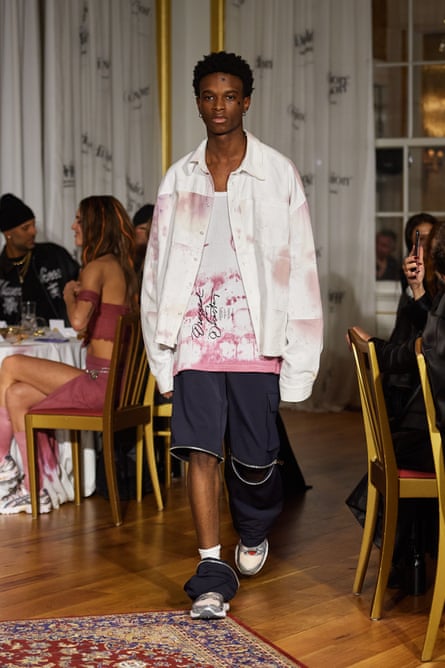
It seemed a trickier area to navigate for the more commercially successful Scandi brands such as Stine Goya, Ganni and Rotate. Known for their signature sparkly dresses and accessories, sequins which have devastating environmental consequences continued to appear multiple times. Rotate claims its versions are sustainable as they are recycled. Ganni say it uses 100% recycled polyester sequins on a 100% recycled polyester backing. A spokesperson for Stine Goya said its team are look for more sustainable options.
Charlotte Eskildsen, co-founder of the Danish label The Garment, thinks it’s about phrasing – and that the word sustainable itself is problematic. She prefers the word “responsible”. “Fashion is never going to be sustainable and we know that we are contributing to an industry that is polluting way more than it should,” adds (di)vision’s Wick.
While Oslo and Helsinki fashion weeks have already implemented Copenhagen’s framework, with New York’s fashion week kicking off many were hopeful that the noise generated by CPHFW could spark wider change, or at least conversation. Caroline Rush, CEO of the British Fashion Council, says London fashion week won’t be following suit. “The event hosts a mixture of established and emerging brands and as result of this setting a one-size-fits-all sustainability standard is not feasible without alienating the smaller businesses.” Instead the BFC says it encourages brands to commit to voluntary initiatives such as joining the UN’s Climate Challenge.
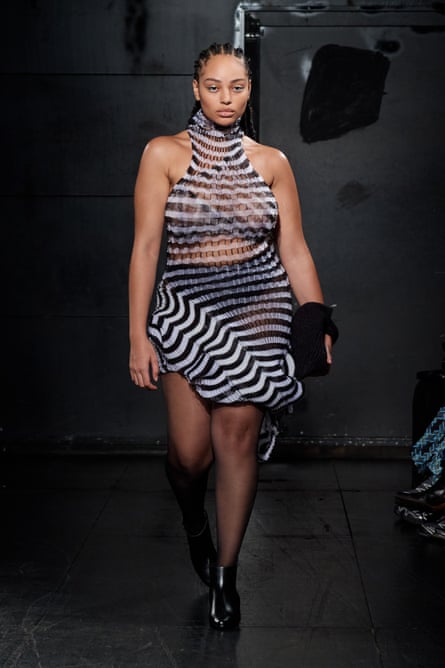
Fiona Gooch, a senior policy adviser at the fair trade organisation Transform Trade, says both an EU regulator and a fashion watchdog as proposed in UK parliament is a better option. “The actions of large brands cause poverty wages and unsafe conditions and undermine smaller fashion brands who regularly use the same suppliers.”
Barry adds: “The Copenhagen fashion week requirements are absolutely better than nothing, but all fashion shows should move forward by introducing sustainability standards that advance further – they could really drive meaningful change in doing so.”
Thorsmark says: “If we rewind three years ago, not a single brand met any of the 18 requirements. Now they do so we will push them again to continue improving.”

